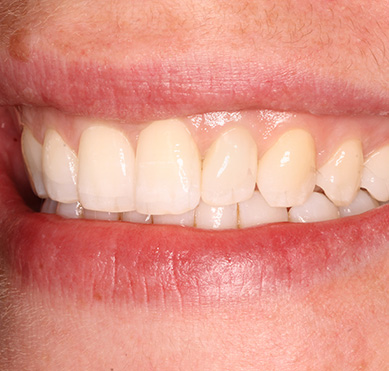The creator of The Online Dentist, Andrew Wilson (GDC number 209563) is an award winning dentist working in Central London. Andrew has a lot of experience with treating discoloured teeth so we’ve asked Andrew to explain all.
If you have a single tooth that has discoloured, it can really stand out in your smile. But there are ways of treating it.
Let’s talk about why one tooth may have discoloured on it’s own. It will usually be because of a trauma or a bang. After a knock to a tooth, the tooth can lose its blood supply and die. If this happens, the tooth can change colour to brown, grey or even purple. It’s basically a bruise within the tooth. Blood has broken down in the tooth and made a bruise. The difference between a bruise in your tooth and a bruise on your arm is that your tooth doesn’t renew itself in the same way that your skin does. So when your tooth gets a bruise, it’s stuck there.
Option 1. Whitening
Whitening is my favourite treatment in this situation. It doesn’t require the removal of healthy enamel. It doesn’t damage the tooth. And it can give you a fantastic result.
It is possible to get a special whitening tray made that allows you to focus on whitening that one discoloured tooth. The tooth is whitened intensively by you at home over a week or so, using slightly different kits from what you would use to whiten all of your teeth.
If the tooth has been root filled, your dentist can take part of the filling out of the back of the tooth to let you get the whitening gel inside the tooth while you whiten. This is really effective at reducing that bruised colour because the gel gets directly to where the bruise is.
The downside to whitening a single tooth is that it is tricky to tell how well it will work. The end result can be slightly unpredictable. It may be that it is not possible to completely get rid of the darker appearance of the darker tooth, especially if it has been like that for several years.
However, it is often extremely effective. It’s usually the best treatment to try first. You’re not removing enamel. You are preserving all of the remaining tooth. Even if it doesn’t work perfectly, it will usually make a huge improvement.
Option 2. Veneers or Crowns
If whitening a single discoloured tooth hasn’t completely worked you may want to try something else.
You may not. A lot of patients will be happy with the improvement after whitening the single tooth, even if it isn’t absolutely perfect.
If you feel that you want to try something else then the good news is that you haven’t wasted your time with the whitening. Any improvement with whitening before placing a veneer will improve the end appearance. Often it will be impossible to disguise a really discoloured tooth with a crown or veneer so whitening first makes it easier.
Once you’ve had some improvement with whitening, you can try a covering for the tooth in the form of a veneer or crown. Be aware, some enamel will almost always have to be removed to place a veneer or crown.
Doing a single veneer or crown and getting it to match to the natural tooth is the hardest thing to do as a dentist. It is so tricky that you need to be aware of a couple of things. The first is that you may need to go to visit the technician who is making your crown so that he or she can meet you and get to see your teeth in real life. By meeting you, the technician can often introduce characteristics to the crown that match your natural teeth and give a much better end result. If there is a chance to go and spend time with the technician, it is well worth doing.
The second thing to be aware of is that this veneer or crown will be more expensive than crowns for back teeth. This is because of the extra work involved and the complexity of this type of treatment.
I firmly believe that you really should have a go at the whitening first but it may be that ultimately something like a veneer is going to give a more predictable end result.
Andrew practices in Central London. If you would like to know more about Andrew or how he could transform your smile, visit his website or contact him.
Recent Articles
 We all want a beautiful, bright smile. Teeth whitening can be a great way to achieve that. If you whiten your teeth with the help of your dentist, it's a...
We all want a beautiful, bright smile. Teeth whitening can be a great way to achieve that. If you whiten your teeth with the help of your dentist, it's a...
 Lots of people have gaps between teeth. Commonly, this happens between your front teeth but you can have a space between any teeth in your mouth. As I write this...
Lots of people have gaps between teeth. Commonly, this happens between your front teeth but you can have a space between any teeth in your mouth. As I write this...






